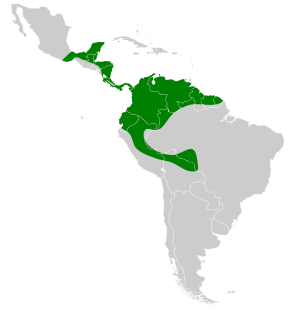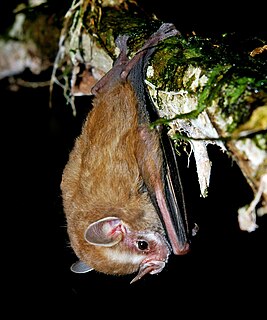
The semipalmated sandpiper is a very small shorebird. The genus name is from Ancient Greek kalidris or skalidris, a term used by Aristotle for some grey-coloured waterside birds. The specific pusilla is Latin for "very small".

The New World leaf-nosed bats (Phyllostomidae) are found from southern North America to South America, specifically from the Southwest United States to northern Argentina. They are ecologically the most varied and diverse family within the order Chiroptera. Most species are insectivorous, but the phyllostomid bats include within their number true predatory species and frugivores. For example, the spectral bat, the largest bat in the Americas, eats vertebrate prey, including small, dove-sized birds. Members of this family have evolved to use food groups such as fruit, nectar, pollen, insects, frogs, other bats, and small vertebrates, and in the case of the vampire bats, even blood.
The least big-eared bat is a bat species of the family Phyllostomidae, found in northwestern Brazil and eastern Colombia. It is the only species within its genus.

The northern little yellow-eared bat is a bat species found from southern Mexico to Bolivia, the Guianas and western Brazil.

The bidentate yellow-eared bat is a species of bat in the family Phyllostomidae, native to South America. Formerly classified in the Vampyressa genus, phylogenetic analyses support its inclusion in Vampyriscus.

The Chatham snipe or Chatham Island snipe is a species of wader in the family Scolopacidae. It is endemic to the Chatham Islands of New Zealand, and is only found on a few islands in the south of the Chatham Islands group.

The least shrew tenrec is a species of mammal in the family Tenrecidae. It is endemic to Madagascar. Its natural habitats are subtropical or tropical moist lowland forest, subtropical or tropical moist montane forest, swamps, pastureland, and irrigated land. It is threatened by habitat loss.

The Aldabra flying fox is a species of megabat in the genus Pteropus. It is endemic to the Aldabra Atoll in the Seychelles, like Chaerephon pusilla, though the latter may be the same species as the little free-tailed bat.

Vampyressa is a genus of bats in the family Phyllostomidae, the leaf-nosed bats. They are known commonly as the yellow-eared bats or yellow-eared vampire bats.

Melissa's yellow-eared bat is a species of bat in the family Phyllostomidae. It is found in southern Colombia, Ecuador and Peru.

Stenodermatinae is a large subfamily of bats in the family Phyllostomidae.

Vampyriscus is a genus of bats in the family Phyllostomidae, the leaf-nosed bats.












